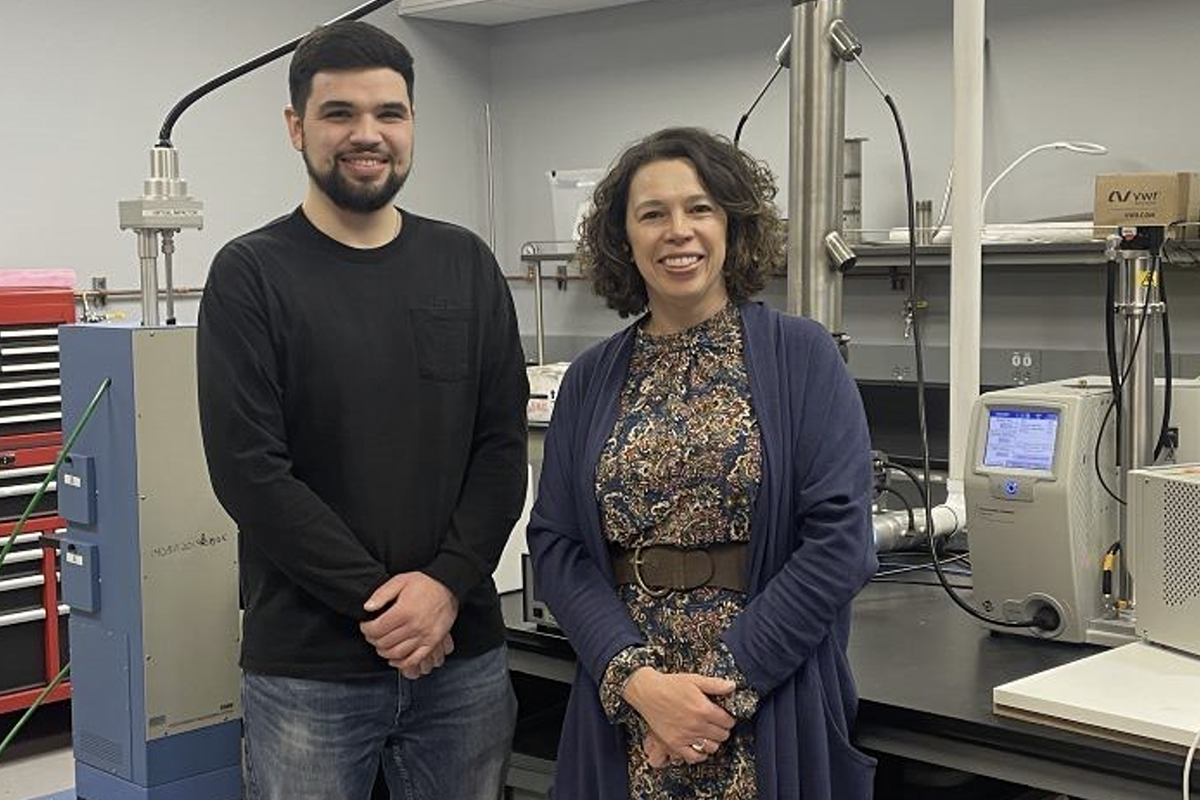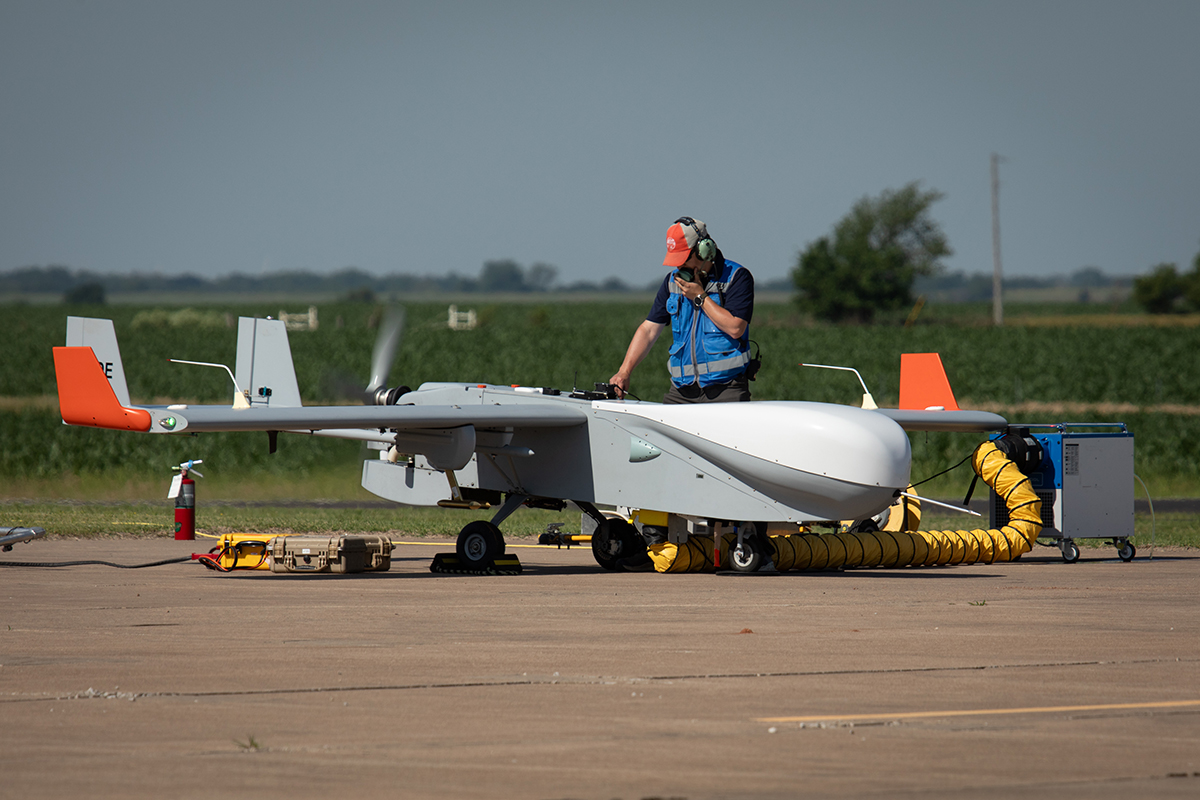First user-driven ArcticShark campaign takes flight in Oklahoma

In the complex dance of atmospheric processes affecting Earth’s energy balance, new particle formation (NPF) is emerging as a center-stage performer—one that helps determine, on a global scale, how clouds absorb and reflect solar radiation.
While some aerosols found in the atmosphere are emitted directly as particles from natural or human sources, other aerosols form in the atmosphere from condensation of gases, such as sulfuric acid, that were themselves emitted by various sources.
Scientists are studying how often NPF occurs in the atmosphere and how it contributes to the formation of cloud condensation nuclei. These seed-like particles are partly where water vapor condenses to make clouds and precipitation.
On May 6, 2024, a small research team from the University of Utah launched Turbulent Layers Promoting New Particle Formation, an Atmospheric Radiation Measurement (ARM) user facility field campaign designed to help scientists better understand the relationship between turbulence and NPF.
With ARM’s Southern Great Plains (SGP) atmospheric observatory in Oklahoma as the source of land-based sensors, this is the first campaign in which ARM users are deploying the user facility’s ArcticShark uncrewed aerial system. Flights were slated to continue into late May.
“This campaign is unique,” says co-principal investigator Gannet Hallar, a fan of the low- and slow-flying measurement platform. “We will be able to observe these atmospheric processes on the ground and in the air.”
Working with Hallar, an ARM data veteran, is her PhD student and co-principal investigator Gerardo Carrillo-Cardenas.
They are starting with an established fact: that within the lower troposphere, commonly called the atmospheric boundary layer, turbulent mixing can help initiate NPF.

Hallar and Carrillo-Cardenas are building upon previous work (Siebert et al. 2004, Wehner et al. 2010, and Wu et al. 2021) that considered the possibility of particle formation from intense mixing between the residual layer and the growing atmospheric boundary layer.
The thinking goes that these vertical thrusts of air would cause intense mixing of air masses, leading to fluctuations in water vapor density and potential temperature. The research team wants to know how this turbulence may enable the supersaturation of precursor gases needed to create a favorable thermodynamic environment for NPF.
To expand on this previous work, Hallar and Carrillo-Cardenas will address two central science questions:
- Comparing NPF aloft and at the surface, are there differences in temporal and ambient environmental conditions?
- If boundary-layer clouds decouple, can the vertical transport of aerosols still be tracked?
“We are really seeking to understand how the movement of the atmosphere itself, at a small scale, impacts the formation of aerosols and what chemical components are needed to spark that formation.”
– Gannet Hallar
“We are really seeking to understand how the movement of the atmosphere itself, at a small scale, impacts the formation of aerosols,” says Hallar, “and what chemical components are needed to spark that formation.”
ASR Work Connects Campaign to Model Improvements
Hallar and Carrillo-Cardenas are working with co-investigator Fangqun Yu, a senior research faculty member at the State University of New York at Albany. Yu will use campaign data to improve Weather Research and Forecasting coupled to Chemistry (WRF-Chem) modeling of NPF as a part of an existing project led by Hallar.
The U.S. Department of Energy’s Atmospheric System Research (ASR) program is funding the project.
The objective of the ASR project is to examine ARM data globally and better understand NPF’s contribution to cloud condensation nuclei. Hallar says that Yu is working on the complex challenges of connecting the chemistry and the regional distributions of NPF.
“I think that this (ArcticShark campaign) will really help add light to some of those challenges by providing a stronger understanding of the vertical distribution of new particle formation, which is often simulated but rarely measured,” says Hallar, “and that’s because we make measurements of new particle formation primarily at the surface of the Earth and not throughout the vertical distribution.”
The key opportunity made possible by the campaign observations, adds Hallar, is applying new perspectives and data to previous modeling assumptions that did not have the benefit of incorporating the vertical distribution of NPF and its relationship to potential turbulence and chemical sourcing.
Hallar says Yu’s contributions will eventually help improve predictions of particle and cloud formation in climate models.
A Great Site for a Flight

With frequent NPF demonstrated in the SGP area, Hallar says the ARM atmospheric observatory is an excellent location to study the relationship between particle formation and turbulence throughout the atmospheric boundary layer. The ArcticShark is collecting atmospheric measurements in the air while ARM instruments on the ground look skyward. This dichotomy will allow researchers to correlate data and build a more complete picture of turbulence and particle formation.
According to the proposal by Hallar and Carrillo-Cardenas, previous research at the SGP concluded that “ground-based observations may not always accurately represent the timing, distribution, and meteorological conditions associated with the onset of NPF” (Chen et al. 2018). And during ARM’s 2016 Holistic Interactions of Shallow Clouds, Aerosols, and Land-Ecosystems (HI-SCALE) field campaign, NPF was observed several hundred meters above the surface near the SGP (O’Donnell et al. 2023).
The ArcticShark is equipped with an aerosol package to collect the data needed to address the campaign’s science questions. This package includes a portable optical particle spectrometer (POPS) and a miniaturized scanning electrical mobility sizer (mSEMS).
The Utah team is also taking advantage of the SGP’s basic meteorological measurements, regular radiosonde launches, and remote sensing instruments, such as Raman lidars and ceilometers.
Building a Path to the Campaign
The origins of the Utah team’s campaign proposal date to 2022 field research in northern Utah’s Heber Valley. It was there, when Carrillo-Cardenas was working on his master’s degree, that he and his colleagues deployed aerosol instruments to calculate how turbulence affects NPF.
“While we were able to do measurements at the surface, we were really interested in learning if surface aerosols could have originally formed higher in the atmosphere,” recalls Carrillo-Cardenas. “But because we only had just surface measurements, we couldn’t formulate the extent of that process.”
Carrillo-Cardenas continued to think about the question when he learned about the opportunity for aerial measurements from the ArcticShark.

At the August 2023 Joint ARM User Facility/ASR Principal Investigators Meeting in Rockville, Maryland, Hallar learned about the upcoming campaign call during an ARM Aerial Facility (AAF) presentation. The talk highlighted technical and programmatic updates on the ArcticShark and how it could help meet ARM user needs.
“I had an opportunity to spend some time with the ArcticShark team, and I got very excited about their technology developments,” says Hallar. “It’s incredible what they’ve achieved and what they have available on the ArcticShark. That inspired me to come back here, talk with Gerardo, and ask ourselves the question, ‘What can we do with this?’”
The September 6, 2023, ArcticShark webinar, says Hallar, was “incredibly useful to helping us understand the ArcticShark better and really refine our questions.”
Hallar adds that she and Carrillo-Cardenas still had a lot of questions, and both AAF Science Lead Fan Mei and AAF Manager Beat Schmid were very responsive. “A big part of the credit for our proposal comes from understanding capabilities, and Fan and Beat provided that and more.”
“We didn’t know this would be the first ArcticShark user campaign until we started writing the proposal,” says Carrillo-Cardenas with a smile. “It was definitely huge when we got the response back (from ARM) that we had won. For me, this will be a great project to learn from.”
# # #Author: Mike Wasem, Staff Writer, Pacific Northwest National Laboratory
This work was supported by the U.S. Department of Energy’s Office of Science, through the Biological and Environmental Research program as part of the Atmospheric System Research program.

